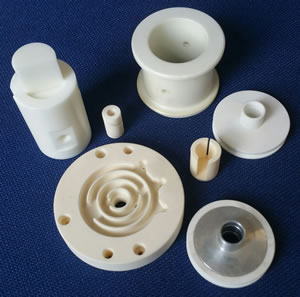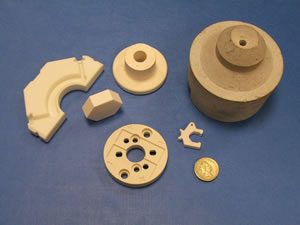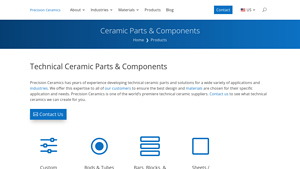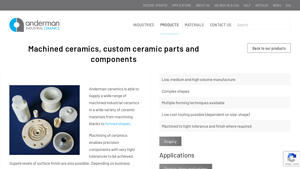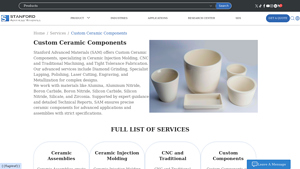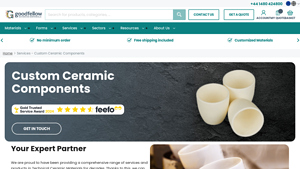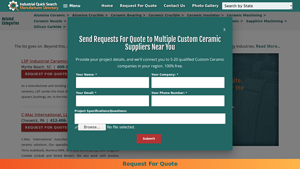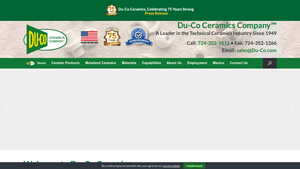Custom Ceramic Parts Guide: Type, Cost, Top List…
Introduction: Navigating the Global Market for custom ceramic parts
In the fast-evolving landscape of global manufacturing, sourcing custom ceramic parts can pose significant challenges for international B2B buyers, especially in regions like Africa, South America, the Middle East, and Europe. The complexity of selecting the right materials, ensuring precise tolerances, and navigating supplier capabilities can be daunting. This guide is designed to simplify the process, offering a comprehensive overview of the various types of custom ceramic components available, their applications across diverse industries, and the critical factors to consider when vetting suppliers.
Buyers will gain insights into the latest advancements in ceramic machining techniques, including green and finish machining, and understand how these methods can impact production costs and timelines. We also explore the importance of high-tolerance measurements and rapid response manufacturing, which are vital for meeting project deadlines.
By equipping B2B buyers with actionable knowledge about sourcing, pricing, and supplier evaluation, this guide empowers informed purchasing decisions. Whether you’re operating in the automotive sector in Brazil or the chemical industry in Nigeria, understanding the nuances of custom ceramic parts will enhance your competitive edge and drive operational efficiency.
Understanding custom ceramic parts Types and Variations
| Type Name | Key Distinguishing Features | Primary B2B Applications | Brief Pros & Cons for Buyers |
|---|---|---|---|
| Technical Ceramics | High strength, temperature resistance, and electrical insulation | Aerospace, Electronics, Medical Devices | Pros: Excellent durability; Cons: Higher costs due to specialized manufacturing. |
| Machined Ceramics | Precision machining with tight tolerances and excellent surface finish | Pump parts, Valves, Gears | Pros: Custom shapes and sizes; Cons: Slower production rates for complex designs. |
| Ceramic Tubes & Rods | Custom shapes, excellent thermal stability, and corrosion resistance | Chemical Processing, Aerospace, Energy Storage | Pros: Versatile applications; Cons: Requires careful material selection based on application. |
| Ceramic Injection Molding | Complex geometries produced through molding techniques | Automotive, Consumer Electronics, Industrial Equipment | Pros: High-volume production capability; Cons: Initial tooling costs can be high. |
| Green Machining | Machining in the “green” state before final firing | Prototyping, Low-cost applications | Pros: Cost-effective for prototypes; Cons: Limited finish quality and tolerances. |
What Are the Key Characteristics of Technical Ceramics?
Technical ceramics are engineered materials known for their exceptional mechanical strength, thermal stability, and electrical insulation properties. They are ideal for high-performance applications in industries such as aerospace, electronics, and medical devices. When purchasing technical ceramics, buyers should consider factors such as the specific application requirements, environmental conditions, and potential for long-term performance. The initial investment may be higher due to specialized manufacturing processes, but the durability and reliability often justify the costs.
How Do Machined Ceramics Stand Out in Precision Applications?
Machined ceramics are characterized by their precision machining capabilities, allowing for tight tolerances and superior surface finishes. These components are commonly used in applications requiring high durability, such as pump parts, valves, and gears. Buyers should evaluate the complexity of the part design and the required tolerances when considering machined ceramics. While they provide excellent customization options, the machining process can be slower, particularly for intricate shapes, impacting lead times for larger orders.
Why Are Ceramic Tubes and Rods Essential for Various Industries?
Ceramic tubes and rods offer unique properties, including excellent thermal stability and corrosion resistance, making them suitable for demanding environments like chemical processing and aerospace. Their customizability in terms of shape and size enhances their versatility across multiple applications, including energy storage. When sourcing these components, buyers must assess the specific material requirements and ensure compatibility with their operational conditions. While they provide broad application potential, careful material selection is crucial to maximize performance.
What Advantages Does Ceramic Injection Molding Offer for Mass Production?
Ceramic injection molding enables the production of complex geometries and intricate designs, making it a preferred choice for high-volume applications in industries such as automotive and consumer electronics. This process allows for efficient scaling of production while maintaining high precision. Buyers should consider the initial tooling costs associated with injection molding, as they can be significant. However, the ability to produce large quantities cost-effectively often compensates for these upfront expenses.
What Is the Role of Green Machining in Prototyping?
Green machining involves working with ceramics in their “green” state, prior to final firing. This method is particularly beneficial for prototyping and low-cost applications, as it allows for quicker iterations and adjustments during the design phase. Buyers should be aware that while green machining is cost-effective, it may result in limitations regarding finish quality and tolerances. This makes it a suitable option for early-stage development but less ideal for final production components requiring high precision.
Key Industrial Applications of custom ceramic parts
| Industry/Sector | Specific Application of custom ceramic parts | Value/Benefit for the Business | Key Sourcing Considerations for this Application |
|---|---|---|---|
| Aerospace | Thermal barrier coatings for engine components | Enhanced durability and performance in extreme conditions | Need for high-temperature resistance and lightweight materials |
| Electronics | Insulators for high-voltage applications | Improved safety and efficiency in electrical systems | Requirements for dielectric strength and precision machining |
| Chemical Processing | Pump components and valves | Resistance to corrosion and wear in harsh environments | Material selection critical for chemical compatibility |
| Medical Devices | Custom ceramic implants and prosthetics | Biocompatibility and longevity in medical applications | Compliance with health regulations and precise manufacturing tolerances |
| Energy Sector | Components for fuel cells and batteries | Increased efficiency and lifespan of energy systems | Focus on thermal stability and material purity |
How Are Custom Ceramic Parts Used in Aerospace Applications?
In the aerospace sector, custom ceramic parts are pivotal in creating thermal barrier coatings for engine components. These coatings protect parts from extreme temperatures while maintaining structural integrity. Buyers in this industry must ensure that the ceramics selected can withstand harsh operational conditions and meet strict regulatory standards. Sourcing considerations include the need for lightweight materials that do not compromise performance, as well as the ability to handle complex geometries.
What Role Do Custom Ceramics Play in Electronics?
Custom ceramic insulators are essential in high-voltage electronics applications, providing safety and efficiency in electrical systems. These components must exhibit excellent dielectric properties and high-temperature stability to prevent electrical failures. For international buyers, particularly in regions like Africa and South America, sourcing high-quality ceramics that meet specific electrical standards is crucial. Precision machining capabilities are also a significant consideration to ensure proper fit and function within electrical assemblies.
How Are Custom Ceramics Beneficial in Chemical Processing?
In chemical processing, custom ceramic parts such as pump components and valves are invaluable due to their resistance to corrosion and wear. These parts are designed to operate in harsh environments, ensuring longevity and reliability. Buyers should prioritize materials that are chemically compatible with the substances being processed. For businesses in the Middle East, where oil and gas processing is prevalent, sourcing ceramics that can withstand extreme conditions is a key consideration.
Why Are Custom Ceramic Parts Important in Medical Devices?
Custom ceramic components are widely used in medical devices, particularly in implants and prosthetics. Their biocompatibility ensures that they can safely interact with human tissue, while their durability contributes to the longevity of medical solutions. Buyers in the medical sector must focus on compliance with stringent health regulations and the need for precise manufacturing tolerances. This is especially critical for international buyers in Europe, where regulatory standards are notably rigorous.
How Do Custom Ceramics Enhance Energy Sector Applications?
In the energy sector, custom ceramic parts are utilized in components for fuel cells and batteries, enhancing their efficiency and lifespan. These ceramics must offer thermal stability and purity to ensure optimal performance in energy systems. For B2B buyers in emerging markets, focusing on suppliers that can provide high-quality materials and reliable production capabilities is essential to meet the growing energy demands while maintaining sustainability standards.
3 Common User Pain Points for ‘custom ceramic parts’ & Their Solutions
Scenario 1: Struggling with Specification and Tolerance Requirements
The Problem: Many B2B buyers encounter difficulties when specifying the correct tolerances and materials for custom ceramic parts. This issue often arises when the end application demands high precision and specific performance characteristics, such as thermal stability, hardness, or corrosion resistance. Miscommunication or lack of clarity in specifications can lead to subpar components that fail to meet operational requirements, resulting in costly production delays and increased project timelines.
The Solution: To effectively navigate this challenge, B2B buyers should engage directly with their ceramic suppliers early in the design phase. Collaborating with application engineers can ensure that all performance specifications are thoroughly understood and met. It’s critical to provide detailed information about the application environment, including temperature ranges, mechanical loads, and any chemical exposure. Suppliers can then recommend appropriate materials, such as alumina for wear resistance or zirconia for thermal insulation, and help determine the necessary tolerances based on the intended use. Additionally, utilizing prototypes can allow buyers to validate designs before mass production, reducing the risk of costly errors.
Scenario 2: Delays in Production and Delivery Times
The Problem: International buyers often face significant delays in the production and delivery of custom ceramic parts, which can disrupt supply chains and project timelines. Factors such as lengthy manufacturing processes, shipping times, and unexpected production issues can lead to frustration and financial losses. Buyers may find themselves under pressure to meet tight deadlines, only to be let down by their suppliers.
The Solution: To mitigate production delays, B2B buyers should look for suppliers who offer rapid response manufacturing and have a track record of reliability. When requesting quotes, inquire about lead times and the supplier’s ability to handle urgent requests. Establishing a strong relationship with a supplier that maintains stock of essential materials can also facilitate quicker turnaround times. Furthermore, consider implementing a just-in-time (JIT) inventory system, which allows for more efficient use of resources and reduces the need for excess inventory. By aligning closely with suppliers on production schedules and utilizing real-time tracking for shipments, buyers can better manage their timelines and reduce the risk of project delays.
Scenario 3: Difficulty in Finding the Right Supplier for Diverse Needs
The Problem: Finding a supplier capable of producing a wide range of custom ceramic parts with varying requirements can be a daunting task for B2B buyers. Many suppliers specialize in specific applications or materials, which may limit options for buyers who require multiple components with different properties or tolerances. This scenario can lead to fragmented sourcing, increased costs, and inconsistencies in quality.
The Solution: B2B buyers should prioritize suppliers that offer a comprehensive range of products and services, including machining capabilities, various ceramic materials, and custom manufacturing processes. Conduct thorough research and leverage supplier directories to identify companies that can meet diverse specifications. Engaging with suppliers that offer one-stop solutions can streamline the procurement process and ensure consistent quality across different components. Additionally, consider utilizing supplier evaluations and feedback from other industry peers to assess the capabilities and reliability of potential partners. By fostering partnerships with versatile suppliers, buyers can simplify their sourcing strategy and ensure that they receive high-quality parts that meet their specific needs.
Strategic Material Selection Guide for custom ceramic parts
What Are the Key Properties of Common Materials Used for Custom Ceramic Parts?
When selecting materials for custom ceramic parts, it’s essential to consider their specific properties that directly impact product performance. Here, we analyze four common ceramic materials: Alumina, Zirconia, Silicon Carbide, and Steatite.
Alumina: Versatile and Cost-Effective
Alumina is one of the most widely used ceramic materials due to its excellent mechanical properties and cost-effectiveness. It boasts high hardness, good wear resistance, and can withstand temperatures up to 1,600°C. Additionally, alumina exhibits strong electrical insulation properties and moderate corrosion resistance, making it suitable for various applications, including electrical insulators and wear components.
Pros: Alumina is relatively inexpensive and easy to machine, allowing for efficient production of complex shapes. Its high durability ensures a long service life in many industrial applications.
Cons: While alumina is resistant to wear, it can be brittle and susceptible to cracking under high-impact conditions. Its corrosion resistance is moderate compared to other advanced ceramics.
Impact on Application: Alumina is compatible with a wide range of media, including chemicals and gases, making it versatile for industries such as electronics, automotive, and chemical processing.
Considerations for International Buyers: Buyers should ensure compliance with international standards like ASTM and DIN, which govern the quality and performance specifications for alumina components.
Zirconia: High Performance in Extreme Conditions
Zirconia is known for its exceptional toughness and thermal stability, making it ideal for high-performance applications. It can withstand temperatures exceeding 2,000°C and offers excellent resistance to thermal shock and corrosion. Zirconia also possesses low thermal conductivity and high dielectric strength.
Pros: Its toughness and resistance to wear make zirconia suitable for applications in harsh environments, such as in aerospace and medical devices.
Cons: Zirconia is more expensive than alumina and can be challenging to machine due to its hardness. This can lead to higher manufacturing costs and longer lead times.
Impact on Application: Zirconia is particularly effective in applications requiring high strength and reliability, such as valve components and cutting tools.
Considerations for International Buyers: Buyers should be aware of specific regional standards and certifications, particularly in industries like aerospace, where compliance with stringent regulations is crucial.
Silicon Carbide: Exceptional Hardness and Thermal Conductivity
Silicon carbide (SiC) is renowned for its hardness, thermal conductivity, and chemical resistance. It can operate at high temperatures (up to 1,600°C) and is often used in applications that require high thermal stability and mechanical strength, such as in semiconductor manufacturing and high-performance bearings.
Pros: SiC’s exceptional hardness and thermal properties make it ideal for wear-resistant components and high-temperature applications.
Cons: The machining process for silicon carbide is complex and costly, which can impact overall production timelines and budgets.
Impact on Application: SiC is particularly suited for environments exposed to abrasive materials or extreme temperatures, making it popular in the automotive and aerospace sectors.
Considerations for International Buyers: Compliance with international standards is critical, particularly for applications in electronics and automotive industries where safety and performance are paramount.
Steatite: Cost-Effective Insulation
Steatite is primarily used for electrical insulators due to its excellent dielectric properties and thermal stability. It can withstand temperatures up to 1,200°C and is resistant to moisture and chemicals.
Pros: Steatite is cost-effective and easy to manufacture, making it a popular choice for high-volume applications.
Cons: Its mechanical strength is lower compared to other ceramics, which may limit its use in high-stress applications.
Impact on Application: Steatite is ideal for electrical applications, including insulators and substrates in electronic devices.
Considerations for International Buyers: Buyers should verify compliance with local and international electrical standards to ensure product safety and reliability.
Summary Table of Material Properties
| Material | Typical Use Case for custom ceramic parts | Key Advantage | Key Disadvantage/Limitation | Relative Cost (Low/Med/High) |
|---|---|---|---|---|
| Alumina | Electrical insulators, wear components | Cost-effective and durable | Brittle, moderate corrosion resistance | Medium |
| Zirconia | Aerospace components, medical devices | Exceptional toughness and stability | High cost, difficult to machine | High |
| Silicon Carbide | Semiconductor manufacturing, bearings | High hardness and thermal conductivity | Complex machining process | High |
| Steatite | Electrical insulators, electronic substrates | Cost-effective and easy to manufacture | Lower mechanical strength | Low |
This guide provides a comprehensive overview of material selection for custom ceramic parts, enabling international B2B buyers to make informed decisions based on performance, cost, and application needs.
In-depth Look: Manufacturing Processes and Quality Assurance for custom ceramic parts
What Are the Key Stages in the Manufacturing Process for Custom Ceramic Parts?
The manufacturing of custom ceramic parts involves several critical stages, each essential for ensuring the final product meets the required specifications and performance standards. Understanding these stages helps B2B buyers assess potential suppliers and their capabilities.
Material Preparation: What Is Involved?
The first stage in manufacturing custom ceramic parts is material preparation. This involves selecting the appropriate ceramic materials based on the application and performance requirements. Common materials include alumina, zirconia, silicon carbide, and steatite. Once selected, the raw materials are processed into a suitable form, often as powders, which may undergo milling to achieve the desired particle size and uniformity.
Following this, the powders are blended with additives to enhance properties such as machinability and strength. Precise control over this stage is crucial, as variations in the material can affect the quality and performance of the final product.
How Are Custom Ceramic Parts Formed?
The forming stage is where the prepared materials are shaped into their desired forms. This can be accomplished using various techniques, including:
- Dry Pressing: A common method where powder is compacted into a mold to form a green body, which is then fired to achieve strength.
- Injection Molding: Suitable for complex shapes, this technique involves injecting a ceramic slurry into a mold. This method allows for high-volume production with intricate designs.
- Slip Casting: A process that uses liquid clay to form shapes by pouring into molds, ideal for large or complex parts.
- Extrusion: This technique is employed to create long shapes such as rods or tubes by forcing the material through a die.
Each method has its advantages and is chosen based on the part’s geometry and production volume requirements.
What Finishing Techniques Are Commonly Used?
Finishing is vital for achieving the required surface quality and dimensional accuracy. This stage may include several processes:
- Machining: Utilizing CNC machining, turning, and milling to refine the shape and achieve tight tolerances.
- Polishing and Lapping: These techniques are used to enhance surface finish, especially for parts that require a high degree of smoothness for functional or aesthetic purposes.
- Coating: Some applications may require additional coatings to improve properties such as wear resistance or conductivity.
This stage is critical as it directly impacts the performance and longevity of the ceramic parts in their respective applications.
What Quality Assurance Measures Should B2B Buyers Expect?
Quality assurance (QA) is integral to the manufacturing process of custom ceramic parts. International and industry-specific standards help ensure that the products meet the necessary quality and safety benchmarks.
Which International Standards Are Relevant for Custom Ceramics?
For custom ceramic manufacturers, adherence to international quality standards such as ISO 9001 is paramount. This standard ensures that the manufacturer has established a quality management system that meets customer and regulatory requirements. Other relevant certifications may include:
- CE Marking: Indicates compliance with EU safety, health, and environmental protection standards.
- API Standards: Important for ceramic components used in the oil and gas industry, ensuring they meet specific performance criteria.
These certifications not only enhance product credibility but also assure buyers of the manufacturer’s commitment to quality.
What Are the Key Quality Control Checkpoints?
Quality control (QC) is typically segmented into various checkpoints throughout the manufacturing process:
- Incoming Quality Control (IQC): This involves the inspection of raw materials before production begins to ensure they meet specifications.
- In-Process Quality Control (IPQC): Throughout the manufacturing stages, continuous monitoring is performed to catch any deviations from standards early in the process.
- Final Quality Control (FQC): After production, the finished products undergo rigorous testing and inspection to confirm they meet the established criteria before shipment.
Common testing methods include dimensional checks, mechanical property assessments, and visual inspections. Advanced techniques may involve non-destructive testing (NDT) to ensure structural integrity without damaging the product.
How Can B2B Buyers Verify Supplier Quality Control?
B2B buyers should take proactive steps to verify the quality control processes of potential suppliers. Here are effective strategies:
- Supplier Audits: Conducting on-site audits allows buyers to assess the manufacturing capabilities and quality management practices firsthand.
- Requesting Quality Reports: Buyers can ask for detailed quality assurance documentation, including test results and compliance certificates, to understand the QC processes.
- Third-Party Inspections: Engaging an independent inspection agency can provide an unbiased assessment of the supplier’s quality control measures and product quality.
What Are the Unique Quality Control Nuances for International Buyers?
For international buyers, particularly those from regions like Africa, South America, the Middle East, and Europe, there are several nuances to consider:
- Regulatory Compliance: Different regions may have varying regulatory requirements that impact product specifications. Understanding these differences is crucial for compliance.
- Cultural Differences: Communication styles and expectations regarding quality may vary by region, necessitating clear dialogue to align on quality standards.
- Logistics and Supply Chain Considerations: International shipping can introduce risks such as damage or delays. Buyers should ensure that suppliers have robust packaging and handling processes to mitigate these risks.
By focusing on these manufacturing processes and quality assurance measures, B2B buyers can make informed decisions when sourcing custom ceramic parts, ensuring that they receive high-quality products that meet their specific needs.
Practical Sourcing Guide: A Step-by-Step Checklist for ‘custom ceramic parts’
Introduction
Sourcing custom ceramic parts requires a strategic approach to ensure that the components meet your specific application needs. This checklist is designed to guide B2B buyers through the critical steps necessary for effective procurement, from defining requirements to selecting the right supplier.
Step 1: Define Your Technical Specifications
Clearly outlining your technical specifications is the foundation of successful sourcing. Consider factors such as material type (e.g., alumina, zirconia), dimensions, tolerances, and performance characteristics like thermal stability and corrosion resistance. This clarity will facilitate better communication with suppliers and help them provide accurate quotes.
Step 2: Identify Your Application Requirements
Understanding the specific applications for the ceramic parts is essential. Different industries, such as aerospace or petrochemical, may have unique standards and regulations. List the performance requirements, such as wear resistance or dielectric properties, to ensure that the selected materials and designs are suitable for your application.
Step 3: Research Potential Suppliers
Conduct thorough research to identify reputable suppliers specializing in custom ceramic components. Look for companies with extensive experience in your industry and positive customer feedback. Utilize platforms like industry directories, trade shows, and online reviews to compile a list of potential candidates.
Step 4: Evaluate Supplier Capabilities
Assess the capabilities of shortlisted suppliers by reviewing their production processes and technologies. Inquire about their machining techniques, material sourcing, and quality assurance measures. Ensure they can handle both prototype and mass production as per your needs, as well as any specific tolerances or surface finishes required.
Step 5: Request and Compare Quotes
Request detailed quotes from multiple suppliers to compare pricing and terms. Ensure that each quote includes information on material costs, production timelines, and shipping fees. Look for transparency in their pricing structures and consider total cost, including potential hidden fees, to avoid surprises later.
Step 6: Verify Supplier Certifications and Quality Standards
Before making a decision, confirm that your chosen supplier adheres to relevant quality standards and certifications, such as ISO 9001. These certifications indicate a commitment to quality and reliability, which is crucial for high-performance ceramic parts. Additionally, ask for samples or references to assess their previous work.
Step 7: Establish Clear Communication Channels
Once a supplier is selected, establish clear communication channels to facilitate ongoing collaboration. Define points of contact and preferred methods of communication to address any potential issues swiftly. Regular updates on production progress and quality checks will help ensure that the project stays on track and meets specifications.
By following this checklist, B2B buyers can navigate the complexities of sourcing custom ceramic parts effectively, ensuring that their procurement process aligns with both technical requirements and business objectives.
Comprehensive Cost and Pricing Analysis for custom ceramic parts Sourcing
What Are the Key Cost Components in Custom Ceramic Parts Manufacturing?
Understanding the cost structure of custom ceramic parts is crucial for B2B buyers. The primary cost components include:
-
Materials: The type of ceramic material significantly affects the cost. High-performance materials like zirconia or silicon carbide tend to be more expensive than alumina. Prices fluctuate based on market demand and availability.
-
Labor: Skilled labor is required for machining and finishing ceramic parts. Labor costs can vary based on the complexity of the part and the level of expertise needed.
-
Manufacturing Overhead: This includes costs associated with maintaining machinery, utilities, and facility operations. Efficient production processes can help minimize overhead costs.
-
Tooling: Custom tooling for specific designs can be a significant upfront investment. The complexity and durability of the tooling will directly influence the overall pricing.
-
Quality Control (QC): Rigorous QC processes are essential in ensuring that parts meet specifications. This adds to the overall cost but is vital for maintaining product integrity.
-
Logistics: Shipping costs can vary widely, especially for international buyers. Factors such as distance, shipping method, and customs duties can significantly impact total costs.
-
Margin: Suppliers typically include a margin that reflects their operational risks and profit goals. Understanding this can help buyers negotiate more effectively.
How Do Pricing Influencers Affect Custom Ceramic Parts Costs?
Several factors influence pricing for custom ceramic parts, particularly for international buyers:
-
Volume/MOQ: Minimum order quantities (MOQs) can affect pricing. Higher volumes typically lead to lower per-unit costs due to economies of scale.
-
Specifications and Customization: Custom designs or specific tolerances can increase costs. The more intricate the part, the higher the manufacturing complexity and associated costs.
-
Material Selection: The choice of materials not only affects performance but also the overall price. Premium materials come with a higher price tag, so balancing performance needs with budget constraints is essential.
-
Quality and Certifications: Parts requiring specific certifications (e.g., ISO, ASTM) often incur higher costs due to additional testing and documentation.
-
Supplier Factors: The supplier’s reputation, location, and production capabilities can influence pricing. Established suppliers with a track record of quality may command higher prices.
-
Incoterms: Understanding international trade terms (Incoterms) is crucial for buyers. These terms dictate the responsibilities of buyers and sellers regarding shipping, risks, and costs, affecting overall pricing.
What Negotiation Strategies Can Help in Sourcing Custom Ceramic Parts?
Effective negotiation can lead to significant savings for B2B buyers. Here are some tips:
-
Leverage Volume: If planning for repeat orders, negotiate better pricing based on anticipated volume. Suppliers are often willing to offer discounts for larger orders.
-
Discuss Specifications: Be clear about your specifications and see if adjustments can be made to lower costs without compromising quality.
-
Consider Total Cost of Ownership (TCO): Look beyond the initial price. Assess long-term costs, including maintenance, performance, and potential downtime, to evaluate the true value of the parts.
-
Explore Supplier Relationships: Building a strong relationship with suppliers can lead to better pricing, priority in production, and more favorable payment terms.
-
Research Market Trends: Stay informed about material costs and industry trends. This knowledge can empower you during negotiations and help identify the best times to purchase.
What Are the Pricing Nuances for International B2B Buyers?
International buyers, particularly from regions like Africa, South America, the Middle East, and Europe, face unique challenges:
-
Currency Fluctuations: Exchange rates can affect pricing significantly. Consider negotiating in a stable currency to mitigate risks.
-
Import Duties and Taxes: Understand the import regulations in your country. Duties can add substantial costs, so factor these into your overall pricing analysis.
-
Lead Times: International shipping can introduce delays. Ensure that lead times align with your project schedules to avoid potential losses.
-
Supplier Location: Proximity to suppliers can impact shipping costs and lead times. Consider local suppliers for smaller orders to reduce logistics costs.
Conclusion
While costs for custom ceramic parts can vary widely, understanding the key components and pricing influencers allows buyers to make informed decisions. By leveraging negotiation strategies and considering the nuances of international sourcing, B2B buyers can optimize their purchasing processes and achieve better value. Always remember that prices are indicative and can fluctuate based on market conditions and specific project requirements.
Alternatives Analysis: Comparing custom ceramic parts With Other Solutions
Understanding Alternatives to Custom Ceramic Parts
When considering solutions for specific industrial applications, businesses often face the challenge of selecting the right materials or technologies that best fit their needs. Custom ceramic parts are renowned for their unique properties, such as high wear resistance, thermal stability, and excellent electrical insulation. However, there are alternative solutions available that may also meet the requirements of various applications. This section will compare custom ceramic parts with two viable alternatives: metal components and polymer-based solutions.
Comparison of Custom Ceramic Parts with Alternatives
| Comparison Aspect | Custom Ceramic Parts | Metal Components | Polymer-Based Solutions |
|---|---|---|---|
| Performance | Excellent wear resistance, high temp stability | High strength, good ductility | Moderate strength, lower temp resistance |
| Cost | Generally higher due to processing | Varies widely; can be lower for simple parts | Typically lower initial costs |
| Ease of Implementation | Requires specialized machining | Easier to machine and fabricate | Simple fabrication and molding |
| Maintenance | Low; highly durable | Moderate; can corrode or deform | High; may require replacements |
| Best Use Case | Extreme environments, precision applications | General engineering, structural applications | Lightweight, less demanding applications |
Detailed Breakdown of Alternatives
Metal Components
Metal parts are traditionally used in many industrial applications due to their strength and ductility. They can be easily machined and fabricated, making them suitable for a wide range of products. However, while metals can perform well in structural applications, they may not withstand extreme temperatures or corrosive environments as effectively as ceramics. Additionally, metals may require regular maintenance to prevent corrosion, adding to their long-term costs.
Polymer-Based Solutions
Polymers offer an attractive alternative due to their lower cost and ease of fabrication. They can be molded into complex shapes and are often used in applications where weight is a concern. However, polymer components usually do not provide the same level of performance as custom ceramics, particularly in high-temperature or high-wear environments. They may also require more frequent replacements, leading to higher lifetime costs in demanding applications.
Conclusion: Choosing the Right Solution for Your Needs
Selecting the right solution for your application requires a thorough understanding of your specific requirements. Custom ceramic parts excel in extreme conditions where high performance is crucial, while metal components offer versatility and ease of use for general applications. Polymer-based solutions may be suitable for less demanding environments where cost is a primary concern. By evaluating the performance, cost, and maintenance needs of each option, B2B buyers can make informed decisions that align with their operational goals and budget constraints.
Essential Technical Properties and Trade Terminology for custom ceramic parts
What Are the Key Technical Properties of Custom Ceramic Parts?
When sourcing custom ceramic parts, understanding the critical technical properties is essential for ensuring optimal performance in specific applications. Here are some of the most significant specifications to consider:
1. Material Grade
Material grade refers to the classification of ceramic materials based on their composition and properties. Common grades include alumina, zirconia, and silicon carbide. Each grade has unique characteristics such as strength, thermal resistance, and electrical insulation. Selecting the appropriate material grade is crucial as it directly impacts the durability and performance of the final product, particularly in demanding environments.
2. Tolerance
Tolerance indicates the permissible limits of variation in a part’s dimensions. In the context of custom ceramic parts, tight tolerances (often in the range of ±0.01 mm) are vital for applications requiring high precision, such as aerospace or medical devices. Understanding tolerance specifications helps buyers ensure that the parts will fit and function as intended, minimizing the risk of operational failures.
3. Surface Finish
Surface finish pertains to the texture and smoothness of the ceramic part’s exterior. High-quality surface finishes are essential for applications involving wear resistance or chemical exposure. A smooth surface can reduce friction and enhance the longevity of components, which is particularly important in mechanical and industrial applications.
4. Coefficient of Thermal Expansion (CTE)
CTE measures how much a material expands or contracts with temperature changes. For custom ceramic parts, a low CTE is desirable, as it indicates stability under varying thermal conditions. This property is especially crucial in applications like electronics, where thermal cycling can lead to failure if materials expand at different rates.
5. Dielectric Strength
Dielectric strength refers to a material’s ability to withstand electric stress without breaking down. For ceramics used in electrical applications, high dielectric strength is essential to ensure safety and reliability. This property is particularly important in sectors like telecommunications and power generation.
What Common Trade Terms Should B2B Buyers Know When Sourcing Custom Ceramic Parts?
Understanding industry terminology can facilitate smoother negotiations and clearer communication with suppliers. Here are some common trade terms relevant to custom ceramic parts:
1. OEM (Original Equipment Manufacturer)
An OEM is a company that produces parts or equipment that may be marketed by another manufacturer. In the context of custom ceramics, buyers often engage with OEMs to ensure that the parts meet specific standards and are compatible with existing products. Knowing an OEM’s capabilities can help buyers assess whether they can deliver the required quality and specifications.
2. MOQ (Minimum Order Quantity)
MOQ refers to the smallest quantity of a product that a supplier is willing to sell. For custom ceramic parts, MOQs can vary significantly depending on the complexity of the design and the manufacturing process. Understanding MOQ is essential for buyers to gauge production costs and manage inventory effectively.
3. RFQ (Request for Quotation)
An RFQ is a formal document sent to suppliers asking for pricing and terms on specific products or services. When requesting custom ceramic parts, an RFQ enables buyers to compare multiple suppliers based on price, delivery time, and technical specifications. A well-prepared RFQ can lead to better pricing and more favorable terms.
4. Incoterms (International Commercial Terms)
Incoterms are a set of international rules that define the responsibilities of buyers and sellers in international transactions. They specify who is responsible for shipping, insurance, and tariffs. Familiarity with Incoterms is critical for B2B buyers, particularly those sourcing from overseas suppliers, as they clarify costs and responsibilities, reducing the risk of disputes.
By understanding these key technical properties and trade terms, B2B buyers can make informed decisions when sourcing custom ceramic parts, ensuring they select the right materials and suppliers for their specific needs.
Navigating Market Dynamics and Sourcing Trends in the custom ceramic parts Sector
What Are the Key Trends Shaping the Custom Ceramic Parts Market?
The custom ceramic parts market is experiencing significant growth driven by several global factors. The increasing demand for high-performance materials across industries such as aerospace, automotive, and electronics is a primary catalyst. These sectors seek components that offer superior thermal stability, wear resistance, and electrical insulation. In addition, the rise of advanced manufacturing technologies, including CNC machining and additive manufacturing, is enabling the production of complex and intricate designs that were previously unattainable.
Emerging sourcing trends highlight a shift towards localized supply chains, particularly in regions like Africa and South America, where logistical challenges have prompted buyers to seek reliable local suppliers. This shift not only reduces lead times but also mitigates risks associated with international shipping and tariffs. Additionally, the integration of digital technologies, such as AI and IoT, is enhancing the precision of manufacturing processes, allowing for greater customization and rapid prototyping. For international B2B buyers, understanding these dynamics is crucial for identifying reliable partners and ensuring timely delivery of high-quality components.
How Can Sustainability Influence Sourcing Decisions for Custom Ceramic Parts?
Sustainability and ethical sourcing are increasingly becoming focal points for international buyers in the custom ceramic parts sector. The environmental impact of ceramic manufacturing processes, which often involve significant energy consumption and raw material extraction, raises concerns among conscientious companies. Therefore, sourcing from suppliers who prioritize sustainable practices is essential. This includes opting for manufacturers that utilize renewable energy, implement waste reduction strategies, and engage in responsible sourcing of raw materials.
Moreover, certifications such as ISO 14001 for environmental management systems and adherence to REACH regulations can help buyers identify suppliers committed to sustainability. The use of ‘green’ materials—such as recycled ceramics or those with lower environmental footprints—can also enhance a company’s sustainability profile. By prioritizing ethical supply chains, businesses not only meet regulatory requirements but also appeal to increasingly eco-conscious consumers and stakeholders, positioning themselves as leaders in corporate responsibility.
How Has the Custom Ceramic Parts Sector Evolved Over Time?
The evolution of the custom ceramic parts sector has been marked by significant technological advancements and changing market demands. Historically, ceramics were primarily used for traditional applications like pottery and tiles. However, with the advent of advanced materials science in the late 20th century, ceramics began to be recognized for their exceptional properties, leading to their adoption in high-tech industries.
The introduction of precision machining and innovative forming techniques allowed for the production of intricate designs with tight tolerances, making ceramics suitable for applications in electronics, aerospace, and medical devices. Today, the sector is characterized by a focus on customization, with manufacturers offering tailored solutions to meet the specific needs of diverse industries. This shift towards bespoke components reflects the broader trend of personalization in B2B manufacturing, driven by advancements in technology and changing customer expectations.
Frequently Asked Questions (FAQs) for B2B Buyers of custom ceramic parts
-
How do I choose the right supplier for custom ceramic parts?
Selecting the right supplier for custom ceramic parts involves evaluating several key factors. Start by assessing their experience and expertise in the specific ceramic materials you need, such as alumina or zirconia. Look for suppliers who offer comprehensive services, including design assistance and rapid prototyping. It’s also essential to verify their production capabilities, quality assurance processes, and certifications. Finally, consider customer reviews and case studies to gauge their reliability and responsiveness, especially for international shipping and communication. -
What are the typical lead times for custom ceramic parts?
Lead times for custom ceramic parts can vary widely based on complexity and quantity. Generally, suppliers should provide initial quotes within 48 hours, but the complete production timeline may range from a few weeks for simple prototypes to several months for large-scale orders. Factors affecting lead times include material availability, machining processes, and finishing requirements. It’s advisable to discuss timelines upfront with your supplier to align on expectations and avoid potential delays in your project. -
What minimum order quantities (MOQs) should I expect for custom ceramic parts?
Minimum order quantities (MOQs) for custom ceramic parts typically depend on the supplier’s production capabilities and the complexity of the parts. Some suppliers may accommodate one-off prototypes, while others might require MOQs ranging from 50 to several hundred units for cost-effectiveness. When sourcing, inquire about flexibility in MOQs, especially if you are testing new designs or entering a new market. This approach helps manage costs while still meeting your business requirements. -
What customization options are available for ceramic parts?
Customization options for ceramic parts are extensive and can include variations in size, shape, and material properties. Suppliers can often provide tailored solutions such as specific surface finishes, coatings, and machining to precise tolerances. Additionally, advanced ceramics can be engineered for unique performance characteristics, such as enhanced thermal stability or corrosion resistance. Engaging with your supplier early in the design process will help ensure that your specific needs are met and optimized for functionality. -
How can I ensure the quality of custom ceramic parts?
To ensure the quality of custom ceramic parts, it’s crucial to partner with suppliers that implement stringent quality assurance measures. This includes using advanced measurement technologies to verify dimensions and tolerances. Request detailed documentation such as Certificates of Analysis (COA) that outline material properties and compliance with industry standards. Regular communication throughout the production process can also help identify and resolve any issues early, ensuring the final product meets your specifications. -
What payment terms are typically offered for international B2B orders?
Payment terms for international B2B orders can vary by supplier but often include options such as upfront payments, partial payments upon order confirmation, and net payment terms upon delivery. Common methods of payment include wire transfers, letters of credit, and online payment platforms. It’s important to clarify these terms before placing an order, considering factors like currency exchange rates and transaction fees that may affect the overall cost. -
What logistics considerations should I keep in mind when sourcing custom ceramic parts?
When sourcing custom ceramic parts internationally, logistics play a critical role in ensuring timely delivery. Consider factors such as shipping methods, customs clearance processes, and potential tariffs or duties that may apply. Work with suppliers experienced in international shipping to facilitate smooth logistics and minimize delays. Additionally, tracking shipments and understanding the local regulations in your region will help mitigate risks associated with transportation and delivery. -
What industries commonly use custom ceramic parts?
Custom ceramic parts are utilized across a diverse range of industries due to their unique properties. Common applications include aerospace, automotive, electronics, medical devices, and chemical processing. Ceramics are favored in these industries for their high-temperature stability, wear resistance, and electrical insulation properties. When sourcing, consider the specific requirements of your industry to ensure that the ceramic parts meet the necessary performance standards and regulatory compliance.
Important Disclaimer & Terms of Use
⚠️ Important Disclaimer
The information provided in this guide, including content regarding manufacturers, technical specifications, and market analysis, is for informational and educational purposes only. It does not constitute professional procurement advice, financial advice, or legal advice.
While we have made every effort to ensure the accuracy and timeliness of the information, we are not responsible for any errors, omissions, or outdated information. Market conditions, company details, and technical standards are subject to change.
B2B buyers must conduct their own independent and thorough due diligence before making any purchasing decisions. This includes contacting suppliers directly, verifying certifications, requesting samples, and seeking professional consultation. The risk of relying on any information in this guide is borne solely by the reader.
Top 7 Custom Ceramic Parts Manufacturers & Suppliers List
1. Precision Ceramics – Custom Technical Ceramic Components
Domain: precision-ceramics.com
Registered: 2013 (12 years)
Introduction: Precision Ceramics specializes in developing technical ceramic parts and solutions for various applications and industries. They offer custom components including rods, tubes, bars, blocks, plates, and sheets/substrates. Key features include rapid response manufacturing with quotes typically provided within 48 hours, high-tolerance measurement using advanced ceramic measurement technology, and sca…
2. Earth Water Fire – Custom Machined Ceramics
Domain: earthwaterfire.com
Registered: 1999 (26 years)
Introduction: Machined ceramics, custom ceramic parts and components; Types of machining: Green machining (low cost, limitations in finish and tolerances) and Finish machining (precision surface finish, tight tolerances, slower process); Processes: Turning, Milling, Cutting/drilling, Honing, Lapping/Polishing; Benefits: Low and high volume production, very tight tolerances, excellent surface finish, precision g…
3. Stanford Advanced Materials – Custom Ceramic Components
Domain: samaterials.com
Registered: 2013 (12 years)
Introduction: Stanford Advanced Materials (SAM) offers Custom Ceramic Components specializing in Ceramic Injection Molding, CNC and Traditional Machining, and Tight Tolerance Fabrication. Services include Diamond Grinding, Specialist Lapping, Polishing, Laser Cutting, Engraving, and Metallization. Materials used include Alumina, Aluminum Nitride, Boron Carbide, Boron Nitride, Silicon Carbide, Silicon Nitride, S…
4. Goodfellow – Custom Ceramic Components
Domain: goodfellow.com
Registered: 1993 (32 years)
Introduction: Custom Ceramic Components offered by Goodfellow include:
– Customized components in machinable ceramics such as Macor®, Shapal™, and Aluminum Nitride.
– Traditional powder formed technical ceramics.
– Laser cutting of ceramic substrates (up to 2mm thick).
– CNC and traditional machining with capabilities for 5-axis CNC, turning, drilling, grinding, and milling.
– Specialist lapping with accur…
5. Ceramic Manufacturing – Custom Ceramics Solutions
Domain: ceramicmanufacturing.net
Registered: 2015 (10 years)
Introduction: Custom ceramics include a wide range of materials such as aluminum oxide, aluminum nitride, silicon carbide, silicon nitride, zirconium oxide, boron carbide, single crystal silicon, yttria, magnesia, and fused silica. They are categorized into four main usage types: structural (bricks, pipes, tiles), refractory (kiln linings, crucibles), whitewares (tableware, cookware), and technical ceramics (us…
6. Intl Ceramics – Custom Technical Ceramics
Domain: intlceramics.com
Registered: 1998 (27 years)
Introduction: Custom Technical Ceramics Manufacturing specializes in designing and manufacturing advanced ceramic components tailored to specific applications. Key features include diverse material options (alumina, zirconia, silicon carbide, silicon nitride), precision manufacturing techniques (green machining, hot pressing, injection molding), and design flexibility for complex geometries. Benefits include pe…
7. Du-Co Ceramics – Standard Ceramic Products
Domain: du-co.com
Registered: 2000 (25 years)
Introduction: Du-Co Ceramics Company offers a range of ceramic products including:
– Standard Ceramic Products: Steatite Ceramic, 96% Alumina Ball & Socket, Fish Spine Beads, Ceramic Post Terminal Caps and Skirts, Standard Ceramic Band Heater Insulators, Ceramic Resistor Cores, Ceramic Bushings (Standard Grooved, Standard Ribbed, Steatite Cup, Steatite Shoulder), Metalized Steatite Bushings, Ceramic Washers, C…
Strategic Sourcing Conclusion and Outlook for custom ceramic parts
In the rapidly evolving landscape of custom ceramic parts, strategic sourcing emerges as a critical component for international B2B buyers seeking to enhance operational efficiency and product quality. By partnering with experienced suppliers who offer a range of advanced materials and manufacturing capabilities, businesses can ensure they receive high-tolerance components tailored to their specific needs. The ability to rapidly prototype and scale production—whether for small batches or large orders—can significantly reduce lead times and facilitate timely market entry.
Moreover, understanding the diverse applications of ceramics across industries such as aerospace, automotive, and chemical processing allows buyers to make informed decisions that align with their operational goals. As global demand for durable, high-performance materials continues to rise, investing in custom ceramic solutions can lead to substantial competitive advantages.
Looking ahead, now is the opportune moment for businesses in Africa, South America, the Middle East, and Europe to leverage the benefits of advanced ceramic technologies. By actively engaging with suppliers who prioritize innovation and quality, companies can position themselves for future growth. Take the next step in your sourcing strategy—explore partnerships that drive performance and deliver value in your projects.
